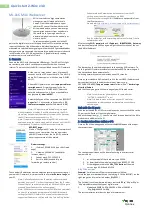
March 2013
Dell EqualLogic Configuration Guide v14.1
2-23
2.3
Optimizing for High Availability and preparing for Array
Firmware updates
Business critical data centers must be designed to sustain various types of service interruptions. In an
EqualLogic SAN environment, software, servers, NICs, switches, and storage are all interdependent
variables that need tuning and configuration with best practices in order to ensure high availability (HA)
and non-disruptive operations.
Plan a maintenance window for upgrades if all configuration is not done for proper failover.
Causes of service disruptions:
•
Hardware failure – Server, NIC, Cable, Switch, Storage, Controller, Disk, and others
•
Software failure – Bugs or Defects, Application Crashes, and others
•
Firmware upgrades – Software Patches, Driver Updates, Firmware Updates
A redundant design will survive most of the possible types of service disruptions, but in some cases
redundancy alone is not enough. The iSCSI data path is the most crucial point of failure in an
EqualLogic SAN environment, and is the focus of this section.
Configuring and tuning your environment with best practice recommendations to design for High
Availability and Non-Disruptive Operations can prevent:
•
connections to volumes dropping
•
application timeout
•
group and/or array failure
2.3.1
Verify hosts are designed for high availability
Designing and configuring hosts for high availability helps minimize the chance of disruptions.
Recommended settings and configuration options on hosts running in the EqualLogic
environment are detailed below:
•
Install EqualLogic Host Integration Tools (HIT) on all supported operating systems.
•
The host software modules change recommended settings for iSCSI Disk Timeouts.
2.3.2
Microsoft Windows Servers
The Windows Disk I/O timeout parameter is set automatically when EqualLogic HIT for Windows is
installed. The TimeOutValue Parameter can be increased to avoid disk I/O timeouts. Verify that the
Windows Disk I/O timeout parameter in the Registry Editor is set to no less than 60 seconds.
2.3.3
VMWare ESX Servers
In vSphere 5.x, VMware allocates five seconds for an iSCSI session to login to an iSCSI target. In a
normal environment this period of time is sufficient. However, it has been observed that this five
second timeout is not long enough to process the large number of iSCSI login requests that occur
after a network failure, switch reboot, or controller failover.
It is recommend that the iSCSI Login Timeout value be increased to 60 seconds.
Содержание EqualLogic PS4100E
Страница 18: ...March 2013 Dell EqualLogic Configuration Guide v14 1 1 9 Figure 2 Fully connected controller failover ...
Страница 54: ...March 2013 Dell EqualLogic Configuration Guide v14 1 6 45 Figure 13 Replication Process ...
Страница 86: ...March 2013 Dell EqualLogic Configuration Guide v14 1 7 77 Figure 27 Minimum cabling scenario PS6100 ...
Страница 133: ...March 2013 Dell EqualLogic Configuration Guide v14 1 13 124 Figure 44FS7610 network ...
















































